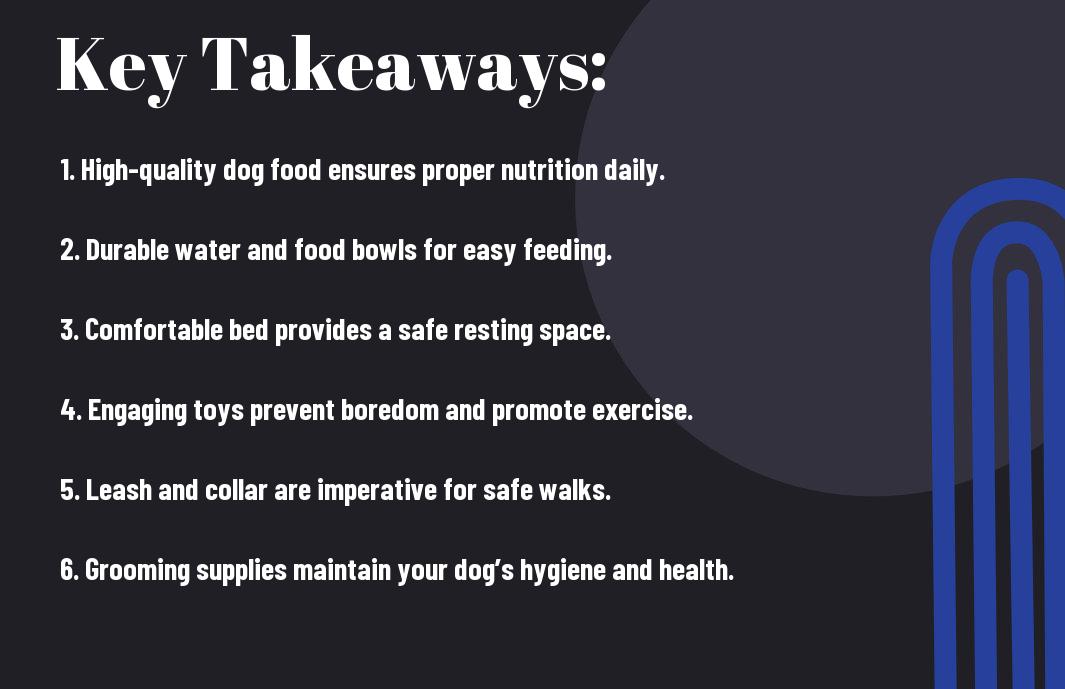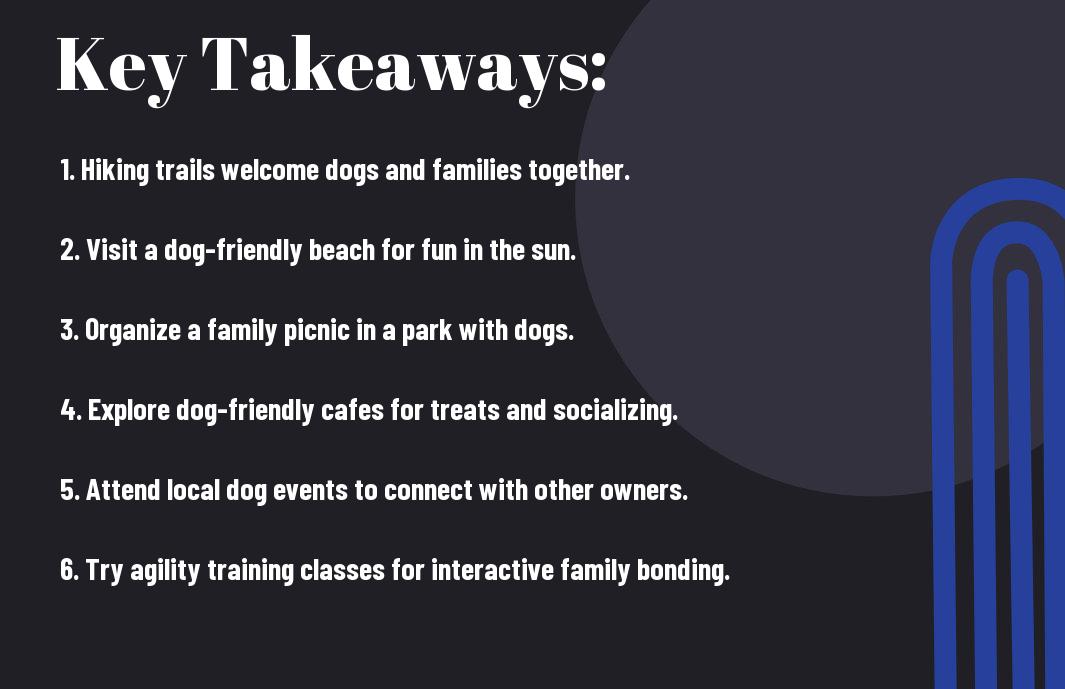You are about to welcome a new furry friend into your home, and making a safe and smooth introduction is key to ensuring a happy household. It’s necessary to take the time to prepare your family and your new dog for this change, as easy steps can foster trust and harmony between them. From establishing a comfortable space to understanding your dog’s body language, this guide will provide you with practical tips to create a positive experience for everyone involved.

Understanding Your Current Family Dynamics
For a smooth introduction of a new dog into your household, it’s important to first understand your family’s unique dynamics. The way you interact with each other, your routines, and how existing pets relate to one another can significantly impact how well a new dog will fit into your home. By taking the time to evaluate these aspects, you can identify potential challenges and opportunities for harmonious coexistence.
Assessing Your Family’s Lifestyle
Dynamics within your family play a vital role when bringing in a new pet. Take a step back and assess your family’s daily routines, schedules, and overall lifestyle. Are there long periods during the day when someone is home, or is everyone out for work and school? Does anyone in your household have allergies or sensitivities to pets? Understanding these factors will help you determine what type of dog might be a good fit, including considerations such as energy level, breed suitability, and whether you are able to provide the attention and exercise a new dog will need.
Evaluating Existing Pets’ Behavior
Little is more important than gauging how your current pets might react to a new companion. Take a close look at your pets’ behavior in various situations. Are they territorial, laid back, or social? Assess whether they display any signs of stress, aggression, or anxiety when interacting with other animals. Observing their behavior can provide insight into what may be a seamless or challenging introduction process.
Your pets are likely to have established territories and routines that they are comfortable with. Addressing any behavioral issues upfront can prevent conflicts from arising when a new dog enters the mix. Be aware of how often they play with other dogs or how they react when encountering unfamiliar animals. Analyzing these patterns can help you create a strategy for introducing the new dog to minimize any disruptions.
Identifying Family Members’ Roles
To ensure harmony in your household when introducing a new dog, identifying each family member’s role is vital. Determine who will take on primary responsibilities, such as feeding, walking, and training the new addition. Clear communication and a shared understanding of responsibilities can foster a positive environment and establish a routine for all family members, including the new dog.
Family members may naturally gravitate toward different roles based on their interests and daily schedules. Encourage everyone in your household to participate in the new dog’s care to promote bonding and integration. When everyone is engaged, it not only helps your new dog settle in faster but also strengthens the bonds within your family.
Factors to Consider Before Bringing a New Dog Home
Some factors play an important role in ensuring a smooth transition when bringing a new dog into your family. It’s necessary to evaluate these elements prior to making your decision:
- Choosing the Right Breed
- Age and Size Considerations
- Energy Levels and Activity Needs
- Behavioral Traits and Temperament
Choosing the Right Breed for Your Family
Home is where love resides, and when it comes to adding a new dog to your family, the right breed can make all the difference. Different dog breeds have distinct characteristics that can align with your family’s lifestyle. Consider how your family’s dynamics, such as children and other pets, might influence which breed will fit in seamlessly. For example, a golden retriever is known for its friendly demeanor and is often great with kids, while a chow chow might be less tolerant of rambunctious play.
Additionally, you must factor in the dog’s size and how it correlates to the space you have at home. If you live in an apartment, a smaller breed like a pug may be more suitable compared to a large German shepherd. By aligning the dog’s breed with your family’s lifestyle, you pave the way for a harmonious coexistence.
Age and Size Considerations
One of the key decisions you will face is whether to adopt a puppy or an older dog. Puppies may bring a certain charm and vitality, but they also require extensive training, socialization, and time to develop into well-mannered companions. Older dogs, on the other hand, may already have settled temperaments and can sometimes adapt to family life more readily. Considering your family’s schedule and availability for training and exercise is necessary when making this choice.
Furthermore, the size of the dog can impact both your living situation and your family’s lifestyle. Larger dogs typically require more space and might not be suitable if your home is limited in area. Conversely, smaller dogs may adapt better to apartment living but often possess higher energy levels that will still require your attention and care.
Understanding the age and size of the dog you wish to adopt will better prepare you for the responsibilities that come with dog ownership.
Energy Levels and Activity Needs
Choosing the right dog also includes evaluating their energy levels and activity needs. Each breed varies considerably in their need for exercise and playtime. For instance, a border collie is a high-energy breed that requires daily vigorous exercise, while a bulldog may be perfectly content with leisurely walks and brief play sessions. It is necessary to assess your family’s routine and lifestyle when selecting a dog, as this will dictate how well the dog can fit into your home life.
Additionally, you should consider your family’s willingness to engage in structured activities like training, jogging, hiking, or games. All of these aspects play a role in determining whether you can meet the dog’s requirements for interaction and exercise.
Levels of energy in dogs can significantly affect your family life. Choosing a high-energy dog when your family leads a sedentary lifestyle might result in challenging behavior and frustration.
Behavioral Traits and Temperament
Clearly, understanding the behavioral traits and temperament of a dog is vital in making a successful selection. Each breed comes with its personality traits, and recognizing these characteristics can impact how well a new dog integrates into your family dynamics. For example, breeds known for their loyalty, like the Labrador retriever, typically thrive in environments full of social interactions, whereas more independent breeds such as the Shiba Inu may require a different approach.
Alongside breed characteristics, it’s necessary to evaluate individual Temperament in any dog you’re considering. Dogs that are known to be aggressive or overly anxious may pose challenges, especially in family settings. Choosing a breed with a calm and friendly disposition usually provides a more positive experience for everyone involved.
Your diligence in evaluating a dog’s behavioral traits and temperament will ultimately lead to a better fit for your family, ensuring a more joyful and stress-free integration.

Preparing Your Home for a New Dog
Keep in mind that a well-prepared home can make the transition smoother for both you and your new canine companion. By creating a welcoming atmosphere and ensuring safety, you help your dog to settle in and feel comfortable. It’s necessary to consider what will make your dog feel secure and what will keep them from getting into trouble.
Creating a Safe Space for the Dog
While preparing for your new dog, it’s important to set up a dedicated space where they can feel safe and relaxed. This area should include a cozy bed, some toys, and easy access to food and water. It’s a great idea to choose a spot that is away from high traffic areas but still allows your dog to observe family activities, so they feel included. This safe space gives your new pet a refuge to retreat to when they need a break.
You should also consider the potential stressors your dog may face in their new environment. The sounds of household appliances or busy children can be overwhelming, especially if they’re not used to those noises. By having a designated zone and involving soft bedding or familiar smells from their previous home, your new dog can feel more stable and less anxious during the adjustment period.
Dog-Proofing Your Living Environment
Any time you bring a new dog into your home, you need to actively dog-proof your living space. This involves clearing away items that could be harmful, such as exposed electrical cords, small objects that a curious dog might swallow, and toxic plants. Consider securing chemicals and cleaning products in high cabinets or locked areas to prevent any accidental ingestion.
Living in a secure environment means removing tempting items that might be chewed on or destroyed. It’s also wise to assess any outdoor spaces, ensuring fences are in good condition and any gaps or holes are sealed, allowing your dog to explore their environment safely. Thoroughly checking for potential hazards will help you avoid unhappy incidents and create a more harmonious living situation for everyone.
Gathering Essential Supplies
Living with a new dog means you will need to gather necessary supplies for their daily care. This includes food and water bowls, appropriate dog food, a collar, leash, harness, grooming tools, and an array of toys to keep your pet entertained. It’s wise to invest in high-quality products that suit your dog’s size and breed, enhancing both their comfort and your convenience.
Your dog’s health and happiness largely depend on having the right supplies at hand. You should also think about what they will need as they settle in, such as regular vet visits, vaccinations, and appropriate flea and tick prevention. Being well-prepared not only makes the initial days easier but also contributes to a long and fulfilling relationship with your new furry family member.

Family dynamics can change dramatically with the addition of a new dog, so it’s vital to handle the introduction properly. To ensure a smooth transition and a positive experience for everyone, including your new furry friend, you need to prepare your home, set clear boundaries, and monitor interactions closely. In this guide, you’ll discover effective techniques to make your new dog feel comfortable and welcomed while keeping your family’s safety in mind.
Managing Interactions Between Pets and Family
Once again, introducing a new dog to your family requires careful planning and attention to ensure that everyone, both human and canine, thrives in the new environment. Managing interactions between your existing pets and your new dog will help facilitate a smooth transition and establish a harmonious home. With each family member’s needs and comfort levels in mind, you can create an atmosphere that encourages positive relationships.
Supervising Early Interactions
Even in the initial stages of introducing your new dog, supervision is key. Always keep an eye on early interactions between your new pet and existing family members or pets. Puppies and adult dogs alike can exhibit unpredictable behavior, and it’s vital to intercept any situations that could escalate. By closely monitoring these interactions, you can not only reduce the likelihood of conflict but also encourage positive behaviors through gentle reinforcement.
In addition to observing physical interactions, be mindful of the emotional state of your existing pets. They might feel threatened or unsure of the new arrival, so provide a sense of security by allowing them to approach at their own pace. Always utilize a leash on the new dog during these early meetings, which allows you more control and the ability to manage any unexpected changes in behavior comfortably.
Understanding Canine Body Language
Managing interactions becomes much easier when you take the time to understand canine body language. Your new dog and existing pets will communicate through subtle signals that can indicate their comfort level, anxiety, and intentions. By interpreting these signs, you can take appropriate measures to ensure that everyone feels safe and respected. Look for signals such as tail position, ears back, and lip licking—these can all give insight into your dog’s emotional state.
Body posture is another important aspect of canine communication. A dog that stands tall and wagging its tail is typically expressing friendliness, while a dog that lowers its body or shows its teeth might be fearful or defensive. To foster a calm environment, ensure your family recognizes these signals alongside your new dog’s behavior, allowing you to intervene if needed, keeping all interactions safe.
Establishing Boundaries and Rules
If you want your new dog to integrate smoothly into your family, it is vital to establish clear boundaries and rules from the beginning. This helps set expectations for both the dog and any existing pets, minimizing the risk of confusion and establishing a framework for acceptable interactions. Involve all family members in this conversation, and ensure consistent reinforcement of these boundaries for the best results.
After establishing rules, ensure that your new dog understands them by enforcing them consistently. For example, if you decide that the kitchen is off-limits, be diligent about requiring your new dog to stay out. This consistency will reinforce the rules in your dog’s mind and make it easier for your entire family to engage positively with each other and your new pet.
Body language, as discussed earlier, can also play a role in reinforcing these boundaries. Praise your dog for following the established rules and use calm yet firm commands to redirect inappropriate behavior. Reinforcement will help your new dog learn what is and isn’t allowed in your home, enhancing the safety and comfort of all family members.
Training and Socializing Your New Dog
Now that you’ve welcomed your new furry friend into your home, it’s crucial to focus on training and socializing them effectively. This process not only helps your dog establish good behavior but also ensures they become a well-adjusted member of your family. By investing time in training and socializing, you increase the chances of building a harmonious relationship between your family and your dog.
Importance of Basic Obedience Training
One of the first steps in ensuring a smooth integration of your new dog into your home is implementing basic obedience training. Teaching your dog crucial commands such as “sit,” “stay,” and “come” creates a foundation for effective communication. This not only enhances their safety but also strengthens your bond with each other, as they learn to understand and respond to your cues.
Basic obedience training also plays a significant role in preventing behavioral issues in the future. A well-trained dog is less likely to engage in problem behaviors like excessive barking or jumping up on guests. By establishing these ground rules early, you are promoting a positive environment that helps your new pet feel secure and confident within the family.
Socialization Techniques and Strategies
Training your new dog involves not only obedience but also socialization. This process introduces your dog to a variety of experiences, people, and other animals, helping them become well-rounded and more adaptable. Start the socialization process gradually, introducing your dog to different people, environments, and situations. Use positive reinforcement, such as treats and praise, to encourage them as they encounter new experiences.
Techniques such as attending puppy classes or playgroups can significantly enhance your dog’s social skills. Allow your dog to interact with other friendly dogs while closely supervising the encounters. Exposure to varied environments, including busy streets, parks, and pet-friendly establishments, contributes to reducing anxiety and fearfulness in your dog. The more positive interactions your dog has, the more comfortable they will become in different situations.
Building Trust and Bonding with the Dog
Training is not only about commands; it’s also about building trust and a strong bond with your new dog. Utilize methods that promote engagement and interaction, such as playing games or sharing quiet time together. This creates a sense of security for your dog, making them feel more at home within your family. Building an open line of communication fosters mutual understanding, leading to a deeper relationship.
By consistently showing love, patience, and positive reinforcement during training, your dog will develop a strong sense of loyalty towards you. Socializing your new pet can also help strengthen this bond, allowing both of you to create shared positive experiences that enhance your relationship over time.
Tips for a Smooth Transition and Adaptation
Unlike simply bringing a new dog home, introducing a new canine member to your family can be a delicate process. It’s necessary to ensure it leads to a harmonious relationship for both your family and your new dog. Keeping in mind the following tips will help you navigate this transition with ease:
- Establish a Safe Space for your dog to retreat when feeling overwhelmed.
- Introduce Family Members Gradually to avoid overwhelming your new pet.
- Consistency in routines helps your dog adjust more easily.
- Monitor Behavior actively during the adjustment period to address any issues early.
- Celebrate Progress to build a positive experience for your family and dog.
Patience and Consistency in the Adjustment Period
You need to cultivate an environment of patience and consistency during the adjustment period for your new dog. This phase is vital for your dog’s emotional well-being and helps establish trust. Understand that your new pet may feel anxious or confused in a new setting, and allowing them time to adjust is necessary. Create a consistent schedule for feeding, walks, and playtime to provide a sense of stability.
As your dog acclimates, it’s necessary to reinforce positive behavior by rewarding good actions with treats and praise. Consistently using the same commands and cues will help your dog learn quickly. When you focus on creating a predictable environment, you will notice your new dog will gradually become more relaxed and willing to bond with your family.
Monitoring Behavior and Addressing Issues
Transitioning to a new home can lead to various behavioral issues, which is why it’s necessary to monitor your new dog’s behavior closely. Establishing a connection will require you to observe their interactions with your family and surroundings. If any problematic behaviors arise, such as excessive barking, chewing, or territorial aggression, addressing them promptly is vital. Take the time to evaluate specific situations that trigger these behaviors and seek guidance or training if necessary.
Addressing any behavioral issues swiftly will help prevent them from solidifying into habits. Utilize effective training techniques and positive reinforcement to guide your dog towards acceptable behaviors. Bear in mind, the goal is to nurture a positive relationship between your new dog and your family.
Celebrating Milestones and Progress
Behavioral adjustments are a journey, so it’s important for you to celebrate milestones along the way. Acknowledging improvements, whether it’s your dog learning a new trick or adjusting to family interactions, boosts their confidence and reinforces their progress. Regularly marking these moments will help you and your family cultivate a strong bond with your new dog over time.
Celebrating small wins is vital to maintain motivation for both you and your pet. By recognizing and rewarding progress, you foster an atmosphere of enthusiasm that encourages ongoing learning and adaptation. This positive reinforcement goes a long way in building trust between you and your new dog.
Final Words
Presently, introducing a new dog to your family can be an enriching experience if approached with care and consideration. Start by creating a safe and welcoming environment for your new pet, ensuring that both your family and the dog are comfortable. Gradually introduce your dog to each family member, allowing them to build positive associations and trust. Be mindful of your dog’s body language, and proceed at a pace that suits everyone involved, including your new furry companion.
Your family’s routine may need some adjustments to accommodate your new dog’s needs. This includes establishing boundaries, training routines, and socialization opportunities. Emphasizing teamwork among family members can further support the dog’s adjustment period. Ultimately, your patience and proactive engagement will help cultivate lasting relationships within your household, ensuring that your family and your new dog can enjoy a harmonious life together.
FAQ
Q: What steps should I take to prepare my family for the arrival of a new dog?
A: Preparing your family for the introduction of a new dog involves several key steps. First, hold a family meeting to discuss the new dog and assign responsibilities to each family member, such as feeding, walking, and training. It’s also important to create a comfortable space in your home where the new dog can adjust peacefully. You may want to gather necessary supplies like a bed, food and water bowls, toys, and grooming tools. Additionally, educate your family about dog behavior and communication, so everyone knows how to approach and interact with the dog effectively. This way, everyone is on the same page and feels excited about welcoming the new family member.
Q: How can I introduce the new dog to existing pets in the household?
A: Introducing a new dog to existing pets should be done gradually and carefully. Begin with a neutral territory—such as a park or a front yard—where neither dog feels territorial. Keep both dogs on leashes and allow them to observe each other from a distance, gradually bringing them closer together based on their comfort levels. Use positive reinforcement, like treats and praise, to reward both the new dog and existing pets for calm behavior. After initial introductions, allow them to interact in a controlled environment at home, always under supervision. It’s imperative to remain patient, as it can take time for existing pets to adapt to the newcomer and establish a harmonious relationship.
Q: What should I do if the new dog exhibits signs of anxiety or stress when settling in?
A: If your new dog shows signs of anxiety or stress, it’s important to create a safe and nurturing environment. Provide a quiet space, such as a designated room or a cozy crate, where the dog can retreat when feeling overwhelmed. Stick to a consistent routine for feeding, walks, and playtime to help your dog feel more secure. Avoid overwhelming the dog with too many visitors or interactions during the initial days. Additionally, consider using calming products such as pheromone diffusers or anxiety wraps. If the anxiety persists, consult with a veterinarian or a professional dog trainer who can provide tailored strategies to help your dog adjust and feel comfortable in their new home.










